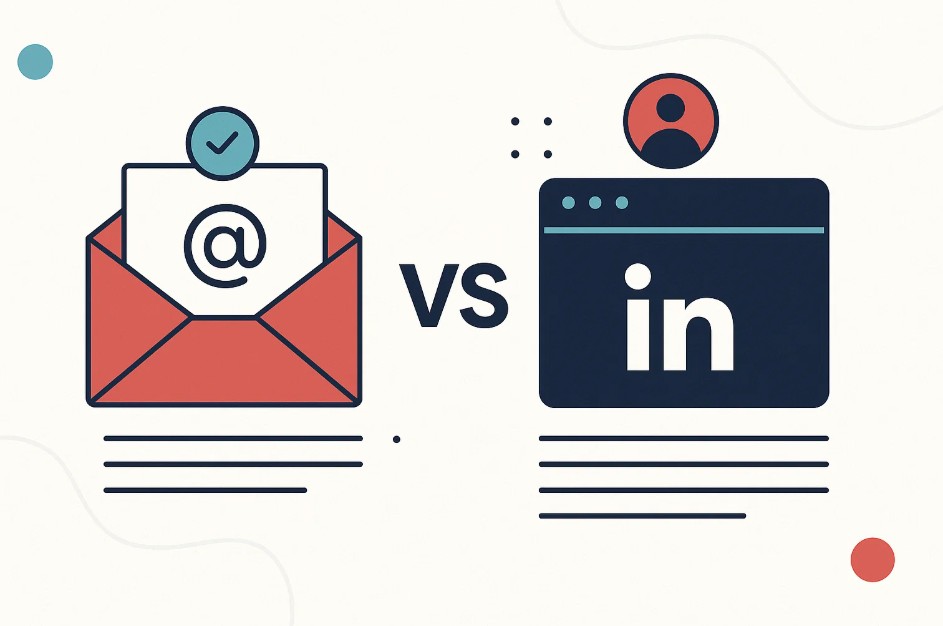Both strategies focus on engaging customers across various touchpoints, but only one delivers a truly seamless, integrated experience that keeps customers coming back. Let’s break down the key differences and why an omnichannel approach is the future of customer-driven marketing.
Contents
- 1 Breaking Down Multichannel Marketing
- 2 Exploring Omnichannel Marketing
- 3 Multichannel vs. Omnichannel Marketing: The Key Differences That Define Success
- 4 Executing an Omnichannel Strategy That Drives Engagement & Growth
- 5 Measuring the Impact of Your Omnichannel Strategy
- 6 Choosing the Best Strategy for Sustainable Growth
- 7 Scale Smarter with Abstrakt
Breaking Down Multichannel Marketing
Multichannel marketing is all about expanding your brand’s reach across multiple platforms—social media, email, websites, physical stores, and beyond. By engaging customers where they are most active, businesses increase visibility, drive interactions, and capture more leads. But without a connected strategy, multichannel marketing can feel disjointed, leading to missed opportunities for deeper engagement.
What Defines Multichannel Marketing?
At its core, multichannel marketing is about leveraging diverse channels to maximize brand exposure. Each platform—whether it’s an Instagram ad, a promotional email, or a brick-and-mortar experience—operates independently. This allows brands to customize messaging based on the strengths of each channel, but it also risks inconsistency in customer experience.
For example, a customer might see a social media ad for a product, receive an unrelated email promotion, and visit a store without a seamless transition between those touchpoints. While this approach increases visibility, the lack of integration can create friction in the buyer’s journey.
The Benefits of a Multichannel Approach
Multichannel marketing remains a powerful tool for customer acquisition and brand awareness—especially when executed strategically.
- Expanded Reach: Engaging customers on multiple platforms ensures your brand remains top-of-mind and accessible wherever they prefer to interact.
- Channel-Specific Optimization: Tailoring content for each platform maximizes engagement. A short, high-impact video might thrive on Instagram, while in-depth, value-driven content performs better in email marketing.
- Brand Visibility & Recognition: When consumers see consistent branding across multiple touchpoints, it reinforces credibility and increases the likelihood of conversion.
- Data-Driven Insights: Tracking performance across different channels provides valuable data on customer behavior, allowing businesses to fine-tune targeting and optimize marketing strategies.
While multichannel marketing is an effective strategy for reaching broader audiences, its real power comes when paired with a fully integrated, omnichannel approach. In today’s competitive landscape, customers expect not just accessibility—but a seamless, connected experience across every touchpoint. That’s where omnichannel marketing takes the lead.
Exploring Omnichannel Marketing
While multichannel marketing focuses on expanding reach, omnichannel marketing is about creating a fully integrated, frictionless customer experience across every touchpoint. Instead of treating each platform as a separate entity, omnichannel marketing ensures that every interaction—whether online, in-store, or through customer support—feels connected, personalized, and consistent.
What Defines Omnichannel Marketing?
Omnichannel marketing is built on data integration, personalization, and consistency. Brands that adopt this strategy don’t just reach customers—they engage them in a meaningful, tailored way based on their behavior, preferences, and past interactions.
Rather than bombarding customers with disconnected messaging, omnichannel marketing leverages real-time data to create a fluid experience. A customer who browses a product on a brand’s website might receive a retargeted email with a personalized discount, followed by a seamless in-store experience where a sales associate already has their purchase history on hand. This level of cohesion increases customer satisfaction and drives higher conversion rates.
The Power of Omnichannel Marketing
A Unified Customer Experience
Customers expect effortless transitions between digital and physical touchpoints. Whether they’re shopping via mobile, engaging with a brand on social media, or visiting a retail location, omnichannel marketing ensures that the experience remains consistent, personalized, and engaging.
Higher Customer Retention & Loyalty
Customers who receive personalized, relevant interactions across all channels are more likely to trust and remain loyal to a brand. Omnichannel marketing nurtures relationships beyond the initial sale—leading to higher lifetime value and repeat purchases.
Data-Driven Personalization
Omnichannel strategies use real-time data tracking to tailor marketing messages, promotions, and recommendations based on individual behaviors. Brands that personalize the customer experience drive up to 40% more revenue than those that don’t.
Increased Revenue & ROI
A seamless buying experience reduces friction in the sales journey. Customers who engage with brands through multiple channels spend 30% more than those who engage with just one. Omnichannel marketing aligns touchpoints to maximize conversions and revenue potential.
If you’re still relying on one-dimensional outreach, you’re already behind. Abstrakt’s omnichannel appointment setting combines data-driven targeting with coordinated messaging across platforms—ensuring your brand connects with the right people, at the right time, on the right channel.
Multichannel vs. Omnichannel Marketing: The Key Differences That Define Success
While both multichannel and omnichannel marketing aim to connect with customers across multiple platforms, their execution and impact differ significantly. One focuses on reach, while the other prioritizes seamless integration—and in today’s digital landscape, that distinction can determine whether a brand thrives or falls behind.
Integration vs. Fragmentation
The biggest difference between these two approaches lies in how well the channels communicate with one another.
- Multichannel marketing operates with separate, independent channels—each functioning on its own. A customer may interact with a brand’s email campaigns, website, and social media, but those experiences don’t necessarily connect.
- Omnichannel marketing, on the other hand, integrates all channels into one seamless experience. Whether a customer starts browsing on mobile, moves to desktop, and later visits a physical location, their journey remains fluid, personalized, and consistent.
Data Utilization
Multichannel marketing collects data separately from each channel, making it difficult to build a complete customer profile. The lack of integration creates gaps in understanding customer behavior, often leading to disconnected messaging and missed opportunities for personalization.
Omnichannel marketing unifies data across all touchpoints, providing a holistic view of customer interactions. This deep integration allows businesses to:
✔ Personalize interactions in real time
✔ Predict customer preferences based on past behaviors
✔ Deliver tailored messaging across every channel
Brands that effectively leverage omnichannel data can anticipate customer needs, deliver hyper-personalized experiences, and maximize engagement.
Customer Experience
- Multichannel marketing prioritizes channel reach, often resulting in a disjointed experience for customers as they move between platforms. One interaction may feel completely separate from another, fragmenting the journey.
- Omnichannel marketing ensures that every customer interaction feels connected, intuitive, and personalized. A customer should be able to abandon their cart on mobile and seamlessly pick up where they left off via email or in-store without friction.
Executing an Omnichannel Strategy That Drives Engagement & Growth
Shifting from multichannel marketing to a true omnichannel strategy requires precision, integration, and a customer-first approach. Brands that prioritize data, consistency, and engagement will deliver seamless experiences—the kind that drive loyalty and long-term revenue.
Unifying Data for Smarter Marketing
Omnichannel marketing starts with data integration. Without a centralized view of customer interactions, businesses risk fragmented experiences that leave customers frustrated.
✔ Consolidate data from every touchpoint—social media, website, email, CRM, and in-store interactions.
✔ Use analytics to map customer behavior, preferences, and buying patterns across channels.
✔ Leverage predictive insights to anticipate customer needs and personalize marketing at scale.
Brands that invest in robust analytics platforms can create hyper-targeted campaigns that feel effortless for customers—but deliver real results for the business.
Consistency Is the Key to Connection
The most successful omnichannel brands ensure that every interaction reinforces a unified brand experience. Whether a customer engages through email, social media, mobile apps, or in-person, messaging, visuals, and offers should remain aligned.
✔ Develop a brand style guide to ensure uniform messaging, tone, and design across all channels.
✔ Synchronize promotions and content across platforms to avoid mixed messages.
✔ Train teams regularly to maintain brand alignment across marketing, sales, and customer support.
When customers receive consistent and cohesive messaging, they trust the brand more and engage at higher rates.
Maximizing Engagement Across Channels
Omnichannel marketing isn’t just about being everywhere—it’s about being everywhere in a way that adds value.
✔ Personalized email campaigns that reflect past interactions and preferences.
✔ Social media engagement that feels real, responsive, and relevant.
✔ Interactive web and mobile experiences that guide users effortlessly through their journey.
✔ Customer feedback loops that show the brand listens and adapts.
Every interaction is an opportunity to strengthen relationships, build loyalty, and create meaningful touchpoints—turning casual buyers into lifelong customers.
The brands that get omnichannel right don’t just market; they create experiences.
Measuring the Impact of Your Omnichannel Strategy
Omnichannel marketing isn’t just about execution—it’s about performance. The brands that dominate the market don’t just launch campaigns; they track, analyze, and optimize based on real-time data. Measuring success is the key to refining strategies that drive revenue, retention, and engagement.
Key Metrics That Define Omnichannel Success
To understand what’s working (and what’s not), businesses need clear performance benchmarks. The right Key Performance Indicators (KPIs) provide valuable insights into customer behavior and the overall impact of omnichannel efforts.
✔ Customer Retention Rate – How many customers return and engage across multiple channels?
✔ Conversion Rate – Which touchpoints and sequences drive action and revenue?
✔ Customer Satisfaction Score (CSAT) – Are customers receiving a seamless, frictionless experience?
✔ Click-Through Rate (CTR) & Social Engagement – How do customers interact with brand messaging across platforms?
Omnichannel Success is a Moving Target
Marketing isn’t static, and neither are customer expectations. The most successful omnichannel brands continuously refine their strategy based on performance data.
✔ Analyze customer feedback—Use direct insights to optimize messaging and engagement strategies.
✔ Refine touchpoints in real time—Adjust promotions, emails, and social campaigns based on what’s driving the highest engagement.
✔ A/B test omnichannel messaging—See how different experiences perform across channels and adjust accordingly.
Data-driven decision-making separates brands that thrive from those that stagnate. The companies that constantly refine, evolve, and optimize their omnichannel marketing are the ones that lead the market.
Choosing the Best Strategy for Sustainable Growth
Omnichannel vs. multichannel marketing—it’s not just about choosing a strategy, it’s about choosing the right strategy for your business goals. While multichannel marketing increases reach and visibility, omnichannel marketing creates seamless, connected experiences that drive customer loyalty and retention.
For brands focused on short-term lead generation, a multichannel approach can expand audience touchpoints and boost awareness. But for businesses that prioritize long-term customer relationships, higher engagement, and higher lifetime value, investing in omnichannel marketing is the smarter move.
Regardless of which approach you take, the key is to stay agile. As the marketing landscape evolves, brands that integrate data, optimize customer experiences, and refine their strategy will consistently outperform the competition.
Scale Smarter with Abstrakt
Ready to maximize your marketing impact? Whether you need a multichannel strategy to increase brand reach or a fully integrated omnichannel approach that nurtures long-term relationships, Abstrakt has the expertise to drive measurable growth.
Let’s build a strategy that delivers real results. Learn more about how our customized B2B lead generation solutions can take your business to the next level.

Madison Hendrix
Madison has worked in SEO and content writing at Abstrakt for over 5 years and has become a certified lead generation expert through her hours upon hours of research to identify the best possible strategies for companies to grow within our niche industry target audiences. An early adopter of AIO (A.I. Optimization) with many organic search accolades - she brings a unique level of expertise to Abstrakt providing helpful info to all of our core audiences.
- Madison Hendrix
- Madison Hendrix
- Madison Hendrix
- Madison Hendrix





